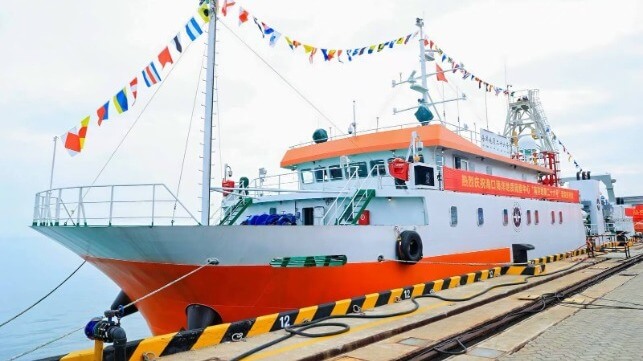Vietnam Protests "Illegal" Activities of Chinese "Reef Survey Vessel"

The government of Vietnam has protested the operations of a new Chinese survey vessel in the Gulf of Tonkin, alleging that the ship is engaged in "illegal" activities in the Vietnamese exclusive economic zone. The two neighbors have overlapping maritime claims in the area, and China's persistent presence in the Vietnamese exclusive economic zone has been a source of friction for decades.
"Vietnam is extremely concerned and resolutely opposes and demands that China end the illegal survey activities of the Hai Yang 26 vessel within Vietnam’s exclusive economic zone and continental shelf," said foreign ministry spokesperson Pham Thu Hang at a press conference last week. "Vietnam also demands that China not repeat such illegal activities."
The vessel in question, Hai Yang Dizhi 26 (“Marine Geology No. 26”) was just delivered to the China Geological Survey (CGS) last month. According to the CGS, the brand new vessel is a DP1 survey ship designed for a range of geological research tasks, like geophysical surveys, bottom sampling and mineral surveys - and more specifically, for studying reefs.
The ship's primary mission is to survey islands and reefs in the South China Sea and evaluate their current status, resources, protection and utilization, with an eye to "strengthen the management and development of sea areas and islands" and support "offshore engineering construction." One observer, Baird Maritime, suggests that the vessel and its tasking may be intended to support China's island structures initiative, which has produced a series of sprawling military bases in the contested Paracel and Spratly Islands.
Hai Yang Dizhi 26 does not appear in AIS or ship registry databases, making open-source analysis of its movements challenging. However, Hang said that the Vietnamese government has engaged with Beijing in "multiple diplomatic exchanges" about the vessel's activities, suggesting that the survey ship has operated in Vietnam's EEZ for some time.
In a follow-up statement Tuesday, newly-appointed Vietnamese President To Lam said that he had raised the matter of maritime relations with China's ambassador. According to the readout, To Lam suggested that the two sides "better control and resolve disagreements at sea; respect each other's legitimate rights and interests; and actively seek satisfactory solutions in accordance with international law, especially the 1982 United Nations Convention on the Law of the Sea (UNCLOS)." He affirmed the longstanding friendship between the two nations, which have deep economic ties and share a Communist heritage.
It is far from the first time that China and Vietnam have clashed over maritime rights. In March, China quietly declared a new baseline for its internal waters along the Gulf of Tonkin, extending it as far as 50 nautical miles seaward from the Chinese coastline. If Beijing's unilateral declaration stands, a crescent-shaped area extending up to 50 nautical miles from the Chinese coast will be fully subject to China's domestic laws. The area appears to include the Hainan Strait, the narrow waterway that connects the northeastern Gulf of Tonkin - and northern Vietnam - with the open ocean.
Hanoi protested the new baseline, but without naming China, and it used less strenuous diplomatic language. "Vietnam believes that coastal countries need to abide by the UNCLOS when establishing the territorial baseline used to calculate the width of the territorial waters and to ensure that it does not affect the lawful rights and interests of other countries," said spokesperson Pham Thu Hang at the time.
